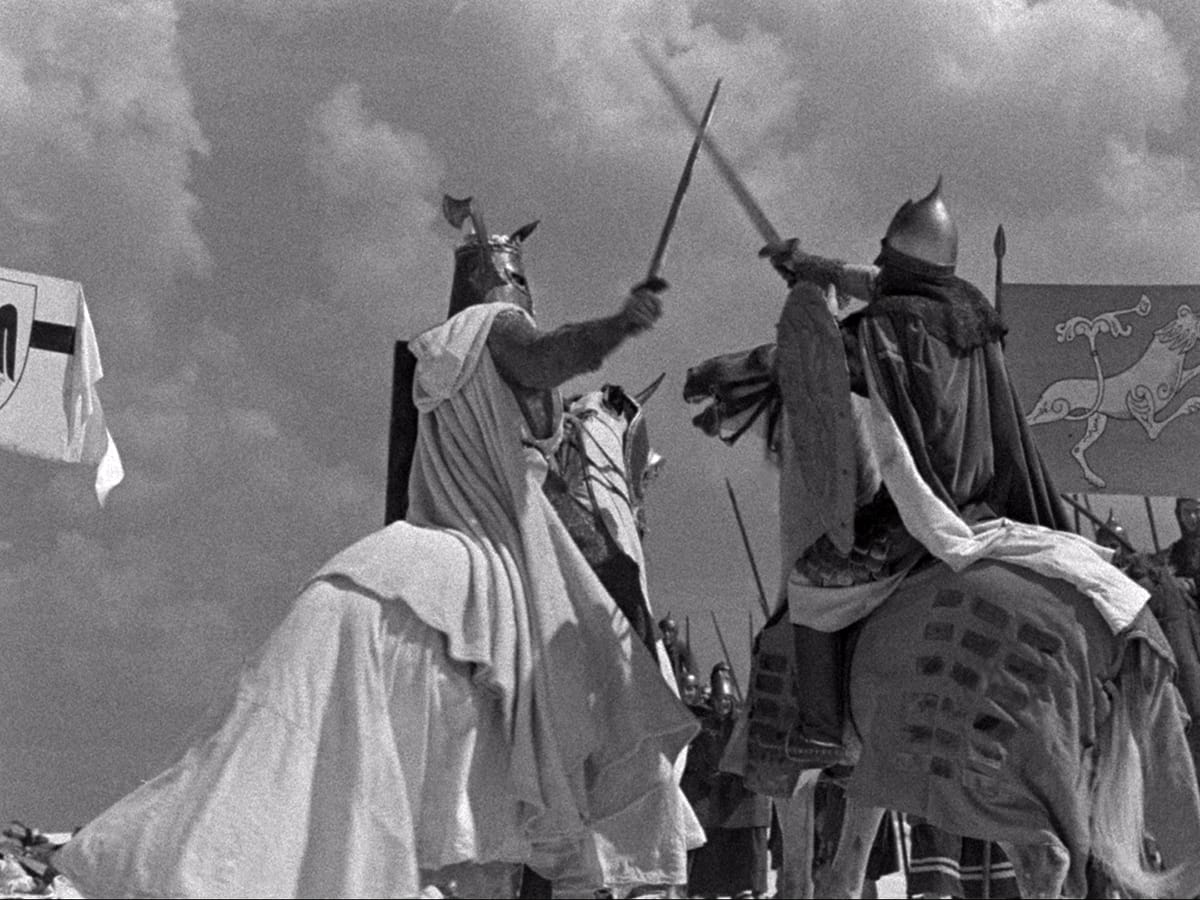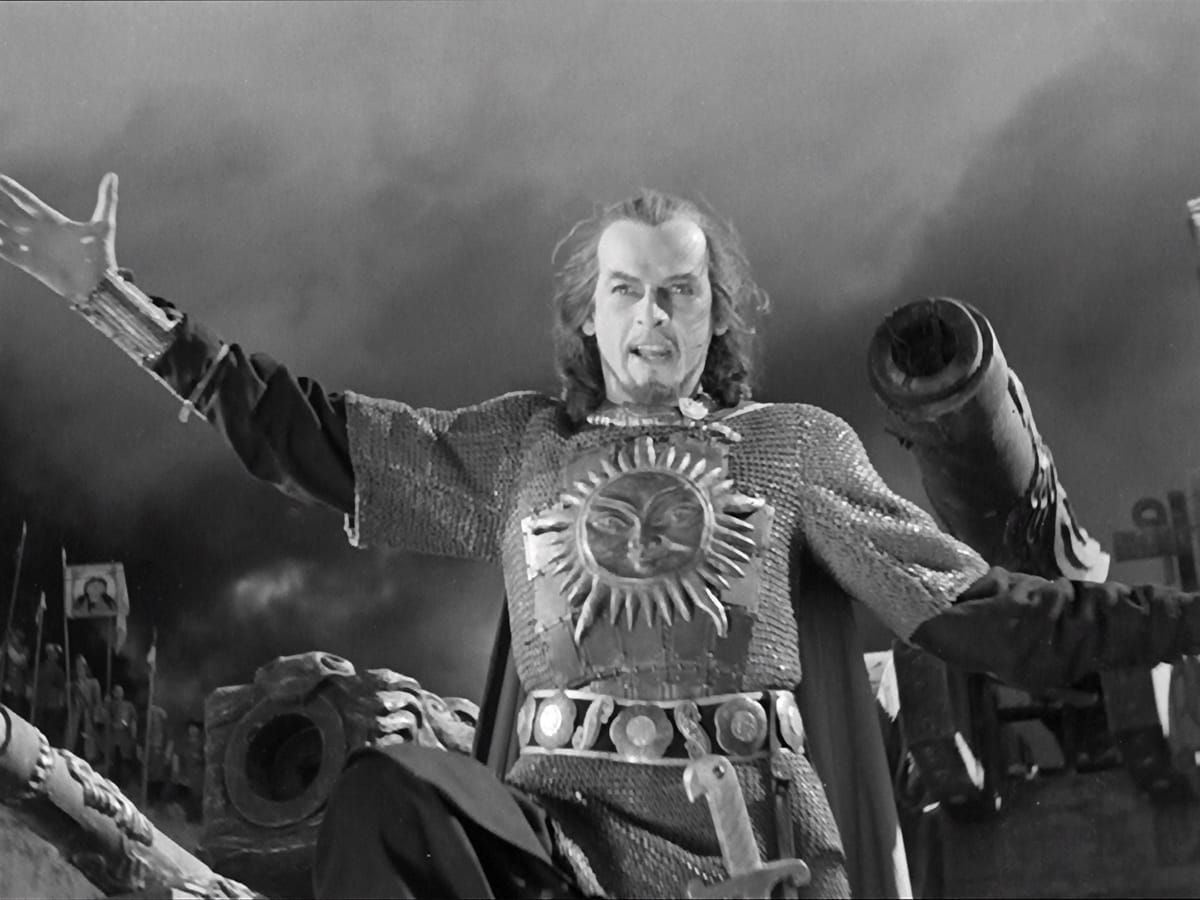Eisenstein: The Sound Years

Sergei Eisenstein, long regarded as a pioneer of film art, changed cinematic strategies halfway through his career. Upon returning from Hollywood and Mexico in the late 1930s, he left behind the densely edited style of celebrated silents like Battleship Potemkin and October, turning instead to historical sources, contradictory audiovisuals, and theatrical sets for his grandiose yet subversive sound-era work. This trio of rousing action epics reveals a deeply unsettling portrait of the Soviet Union under Stalin, and provided battle-scene blueprints for filmmaking giants from Laurence Olivier in Henry V to Akira Kurosawa in Seven Samurai.
Films In This Set
-

Alexander Nevsky
1938
Eisenstein drew on history, Russian folk narratives, and the techniques of Walt Disney to create this broadly painted epic of Russian resilience. This story of Teutonic knights vanquished by Prince Alexander Nevsky’s tactical brilliance resonated deeply with a Soviet Union concerned with the rise of Nazi Germany. Widely imitated—most notably by Laurence Olivier's Battle of Agincourt re-creation for Henry V—the Battle on the Ice scene remains one of the most famous audio-visual experiments in film history, perfectly blending action with the rousing score of Sergei Prokofiev.
-

Ivan the Terrible, Part I
1944
Navigating the deadly waters of Stalinist politics, Eisenstein was able to film two parts of his planned trilogy about the troubled sixteenth-century tsar who united Russia. Visually stunning and powerfully acted, Ivan the Terrible charts the rise to power and descent into terror of this veritable dictator. Though pleased with the first installment, Stalin detested the portrait in the second film—with its summary executions and secret police—and promptly banned it.
-

Ivan the Terrible, Part II
1958
Navigating the deadly waters of Stalinist politics, Eisenstein was able to film two parts of his planned trilogy about the troubled sixteenth-century tsar who united Russia. Visually stunning and powerfully acted, Ivan the Terrible charts the rise to power and descent into terror of this veritable dictator. Though pleased with the first installment, Stalin detested the portrait in the second film—with its summary executions and secret police—and promptly banned it.
THREE-DVD SPECIAL EDITION FEATURES
- Gorgeous digital transfers, all with restored image and sound
- Audio essay on Alexander Nevsky by film scholar David Bordwell
- Multimedia essays on Eisenstein’s collaboration with composer Sergei Prokofiev, the history of Ivan the Terrible, and Eisenstein’s visual vocabulary
- A reconstruction of Eisenstein’s unfinished film Bezhin Meadow, plus rare photos and documents from the set
- Deleted scenes from Ivan the Terrible
- Drawings and production stills
- Restoration demonstration
Covers by Gordon Reynolds
Films In This Set
-

Alexander Nevsky
1938
Eisenstein drew on history, Russian folk narratives, and the techniques of Walt Disney to create this broadly painted epic of Russian resilience. This story of Teutonic knights vanquished by Prince Alexander Nevsky’s tactical brilliance resonated deeply with a Soviet Union concerned with the rise of Nazi Germany. Widely imitated—most notably by Laurence Olivier's Battle of Agincourt re-creation for Henry V—the Battle on the Ice scene remains one of the most famous audio-visual experiments in film history, perfectly blending action with the rousing score of Sergei Prokofiev.
-

Ivan the Terrible, Part I
1944
Navigating the deadly waters of Stalinist politics, Eisenstein was able to film two parts of his planned trilogy about the troubled sixteenth-century tsar who united Russia. Visually stunning and powerfully acted, Ivan the Terrible charts the rise to power and descent into terror of this veritable dictator. Though pleased with the first installment, Stalin detested the portrait in the second film—with its summary executions and secret police—and promptly banned it.
-

Ivan the Terrible, Part II
1958
Navigating the deadly waters of Stalinist politics, Eisenstein was able to film two parts of his planned trilogy about the troubled sixteenth-century tsar who united Russia. Visually stunning and powerfully acted, Ivan the Terrible charts the rise to power and descent into terror of this veritable dictator. Though pleased with the first installment, Stalin detested the portrait in the second film—with its summary executions and secret police—and promptly banned it.

THREE-DVD SPECIAL EDITION FEATURES
- Gorgeous digital transfers, all with restored image and sound
- Audio essay on Alexander Nevsky by film scholar David Bordwell
- Multimedia essays on Eisenstein’s collaboration with composer Sergei Prokofiev, the history of Ivan the Terrible, and Eisenstein’s visual vocabulary
- A reconstruction of Eisenstein’s unfinished film Bezhin Meadow, plus rare photos and documents from the set
- Deleted scenes from Ivan the Terrible
- Drawings and production stills
- Restoration demonstration
Covers by Gordon Reynolds

Alexander Nevsky

Ivan the Terrible, Part I

Ivan the Terrible, Part II